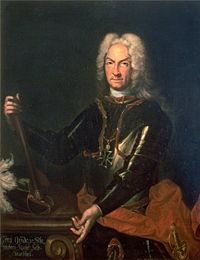Guido von Starhemberg
Count Guido von Starhemberg (born November 11, 1657 in Graz ; † March 7, 1737 , also Guidobald ) was an imperial Austrian general .
Life
Guido, the fourth-born son of Count Bartholomäus from his marriage to Esther Countess von Windischgrätz, was initially determined by his parents for the clergy and was brought up in Graz by the Jesuits . But he followed his military destiny and joined the imperial army at the age of 20. During the siege of Vienna in 1683 he fought with distinction as adjutant to his uncle Ernst Rüdiger von Starhemberg , followed the army to Hungary after the relief of Vienna and did a lot there, including the siege of Ofen in 1686 , Mohács in 1687 and the storming Belgrade (September 6, 1688) and in the Battle of Slankamen (August 19, 1691). In 1692 he was promoted to field marshal lieutenant and appointed commander of the Ehrenbreitstein fortress . In 1693 he was called back to Hungary, where he again proved himself and in 1695 was appointed General Feldzeugmeister.
Together with Eugene of Savoy , Guido von Starhemberg won the decisive battle at Zenta on September 11, 1697 and soon rose to become the most important general in the imperial army alongside the prince. After the outbreak of the War of the Spanish Succession , he went to Italy with Prince Eugene and took part in the siege of Mantua and the battle of Luzzara . In 1703, Prince Eugene was recalled to Vienna, whereupon Count Guido received the supreme command in Italy. He successfully fought against the Duke of Vendôme near Ostiglia , then maneuvered the troops of General Albergotti and was able to prevent the planned unification of the French with the Bavarians under Elector Max Emanuel in South Tyrol through his train to Piedmont . In the same year Starhemberg got into a dispute with Duke Viktor Amadeus II of Savoy , so that he had to be replaced by Field Marshal Wirich Graf Daun .
In 1708 Starhemberg took over command of the Austrian army fighting in Spain as field marshal and, despite the small armed forces available to him, waged the small war victoriously. In 1710, after the victories at Almenara and Saragossa , he moved into Madrid , but was soon forced to retreat to Barcelona after the battle at Villaviciosa and the lack of indifference and indifference of the Spanish people in the cause of Charles. When Karl returned to the Austrian hereditary lands after the death of Joseph I , Starhemberg stayed behind as viceroy in Barcelona , but despite his ingenious tactics and courage that earned him the Spanish nickname el gran capitán , he was unable to get there for lack of support hold and, as a result of the neutrality tract of May 14, 1713, was transferred to Genoa with the remnants of his troops on English ships. He then lived in Vienna. During the Turkish war from 1716 to 1718 he took over the presidium of the court war council in the absence of Prince Eugene . He died on March 7, 1737 as governor of Slavonia . A grave monument for him is in the Teutonic Order Church (Vienna) .
Museum reception
Through the imperial resolution of Franz Joseph I of February 28, 1863, Guido von Starhemberg was added to the list of the "most famous warlords and generals of Austria worthy of perpetual emulation" , in whose honor and memory there was also a life-size statue in the general hall of the time The newly established Imperial and Royal Court Weapons Museum (today: Heeresgeschichtliches Museum Wien ) was built. The statue was created in 1875 from Carrara marble by the sculptor Franz Gastell and was dedicated by Camillo Fürst Starhemberg (1804–1872).
In the Army History Museum there are some other memorabilia from Guido von Starhemberg. In addition to a portrait of Gottfried Kneller , the Turkish arrowhead with which he was wounded during the siege of Ofen in 1686 is also on display. The pommel of his marshal's baton is also exhibited in the Vienna Museum.
literature
- Alfred von Arneth : The life of the imperial field marshal Count Guido Starhemberg. Gerold, Vienna 1853, (online)
- Constantin von Wurzbach : Starhemberg, Guido Graf . In: Biographisches Lexikon des Kaiserthums Oesterreich . 37th part. Kaiserlich-Königliche Hof- und Staatsdruckerei, Vienna 1878, pp. 202–208 ( digitized version ).
- Alfred Ritter von Arneth: Starhemberg, Guidobald Graf von . In: Allgemeine Deutsche Biographie (ADB). Volume 35, Duncker & Humblot, Leipzig 1893, pp. 473-480.
Individual evidence
- ↑ Johann Christoph Allmayer-Beck : The Army History Museum Vienna. The museum and its representative rooms . Kiesel Verlag, Salzburg 1981, ISBN 3-7023-0113-5 , p. 33.
- ↑ Johann Christoph Allmayer-Beck : The Army History Museum Vienna. Volume 3: Hall II - The 18th Century to 1790. Kiesel-Verlag, Salzburg 1983, ISBN 3-7023-4012-2 , p. 24f.
| personal data | |
|---|---|
| SURNAME | Starhemberg, Guido von |
| ALTERNATIVE NAMES | Starhemberg, Guido Graf von |
| BRIEF DESCRIPTION | Austrian general |
| DATE OF BIRTH | November 11, 1657 |
| PLACE OF BIRTH | Graz |
| DATE OF DEATH | March 7, 1737 |


